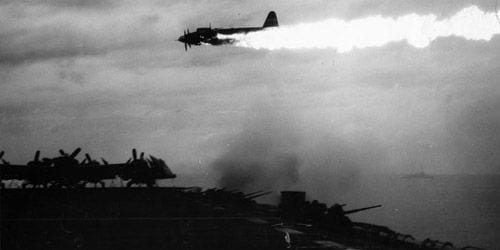
“None of my neighbors knows I was a kamikaze pilot,” says Kazuo Nakajima. A sight man, quick to smile, Kazuo is well aware of the irony of his discretion. During World War II, to be a pilot for Japan, a man who had vowed to give up his life for his nation’s victory, was a great honor. Today, however, the image of the kamikaze is different. Most people — especially those exposed to Western media — consider the pilots and navigators of suicide missions to be “fanatics,” precursors to the 9/11 hijackers in their abject dedication to a cause.
And yet, as Linda Hoaglund and Risa Morimoto reveal in Wings of Defeat, then and now the kamikaze pilots were more complicated and diverse than this reductive impression allows. The documentary, airing 5 May as part of PBS’ Independent Lens, includes interviews with surviving pilots, navigators, and Kazuo, a gunner, in order to reveal the fears and desires that produced kamikaze — the idea and the devastating practice.
Morimoto, born and raised in New York City, was startled to learn in 2005 that her uncle had trained as a kamikaze pilot. Though he had been dead for some 20 years. Morimoto decided to investigate how the man she knew as a gentle, loving family man had ever considered such a fate for himself. She travels to Osaka, camera crew in tow, where she meets with her own aunts as well as other kamikaze participants. Drafted college student and navigator pilot Takehiko Ena shows her the photo taken to mark his induction into the kamikaze corps. “I was 22 when I took off,” he says, “You can see the shadow of death on my face. It looks like a funeral portrait.”
From the start, the kamikaze flyers — a name meaning “divine winds,” borrowed from the typhoons that saved Japan from a 13th-century Mongol invasion fleet — were more accurately selected than volunteered. Young and eager to please, many recruits were workers as well as college and even high school students. Some were beaten and starved into submission, some believed the exhortation that they were the 20th century “gods” who would save their beloved nation from “Western colonialist forces,” says Emiko Ohnuki-Tierney, author of Kamikaze Diaries. With Japan’s “back against the wall,” outgunned and outnumbered, young men accepted their responsibility — some readily and some reluctantly. “No matter what I do, I can’t stand to lose,” insists Shigeyoshi Hamazono, a fighter pilot assigned to the kamikaze corps in 1945. “It’s my pride.”
Certainly individual and collective pride was a factor in kamikaze. But there were other reasons, too. As Morimoto learns, some kamikaze were convinced (or told themselves they were convinced) by the “glorified spin” put on the endeavor of the war, despite the growing feeling that victory was impossible. That’s not to say they weren’t aware of their objective: “I thought, ‘Oh, I have so many things I want to do, but I have to die,” says Kazuo.
Takehiko remembers, “We didn’t go with joy or relish it,” but put on their uniforms and obeyed orders to get into their planes. “Before I knew it,” he smiles, “I was up in the air… At first it felt so wonderful to be up in the sky.” He reads from a farewell letter he wrote at the time: “After a final toast, my doom looms, wretched and unjust,” he says. “A desperate warrior’s will rousing my body. I will plunge headlong into a fiery hell, an abyss of carnage.” Photos display his projected end, a series of horrifically burned bodies, broken and dismembered.
The interviewees are survivors of botched or incomplete missions. Shigeyoshi recalls the flight that was supposed to be his last, but when he and his gunner Kazuo found themselves surrounded by American Corsairs, they unloaded their bombs and engaged in a 30-minute dogfight, one they had no chance to win. Anticipating a grisly but hopefully noble death, Shigeyoshi narrates as the film offers up animated illustrations — zooming planes, bloodied pilots’ faces, chaotic perspectives. Now grateful that the Americans did not, in fact, circle back to finish them off, as he expected, Shigeyoshi says he’d like someday to meet the men who spared his life.
Another set of views are offered by survivors of one kamikaze attack against the USS Drexler. These views are neither simplistic nor accusatory. Fred Mitchell remembers watching the plane approach: “Pieces of the plane kept flying off and he kept coming.” When the plane hit, “just kissed that deck,” Mitchell says, “The whole world exploded.” When he turned toward the explosion, he saw that “guys were just gone, no body parts.” And 49 seconds later, the ship sank. The trauma of that day remains with Mitchell and his fellow survivors, but Duke Payne says, the premise is not unthinkable. “We had people that would have done that,” he says, men devoted to their patriotic duty and convinced of its absolute rightness.
Such a sense of rightness provided a ground for the American attacks on Hiroshima and Nagasaki, after all. For Takehiko, that was the end. “I arrived in Hiroshima on August 7, around 10am,” he recalls. “I witnessed the devastation of the atomic bomb.” Photos show the flattened earth, shards of buildings, and wisps of bodies left behind. “In that place,” he says haltingly, “My warrior spirit simply died.”

![Call for Papers: All Things Reconsidered [MUSIC] May-August 2024](https://www.popmatters.com/wp-content/uploads/2024/04/all-things-reconsidered-call-music-may-2024-720x380.jpg)



